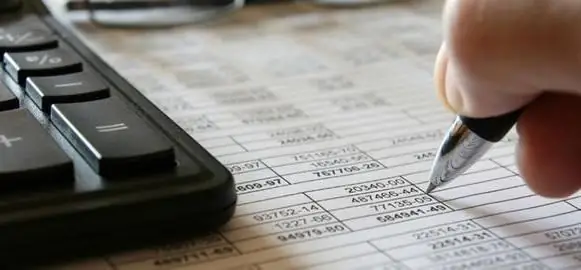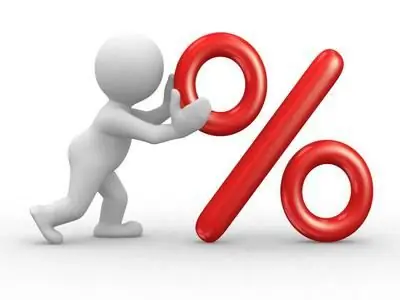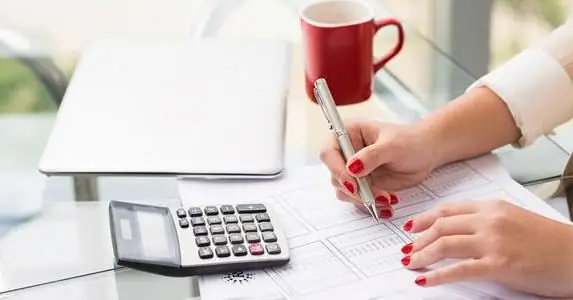2025 Author: Howard Calhoun | [email protected]. Last modified: 2025-01-24 13:10:25
We face VAT tax every time we purchase products in stores and other places. Very often in the cash receipt you can see a separate line "VAT amount 10%" or "VAT amount 18%", and now "VAT amount 20%".
The issues of calculating and applying tax for a long time have always been very relevant in accounting and preparing a declaration.
In the framework of this article, we will consider the question of how VAT is deciphered and what rates are applied today when calculating tax by enterprises.
Concept
Do you understand how the abbreviation VAT stands for? It is this issue that should be de alt with first of all.
The abbreviation VAT (VAT) stands for Value Added Tax. It means the amount that the seller must pay to the state with the difference between the cost of the product at which it was purchased by the end user and the price that the seller paid to the wholesale buyer.
How is VAT deciphered? Three letters, so popular all over the world,explained as follows: value added tax. We all go to stores for groceries or other goods and involuntarily see these letters on the price tags. However, at the end of the day, we don't manufacture this product or sell it through outlets, we just buy it for our needs. VAT is a part of the funds that make up the value added tax on products or services sent to the state budget. If the enterprise has not created this added value, in other words, the final cost of the product is less than the initial price, then there is no VAT liability. It should be noted that this is the most powerful source of replenishment of the state budget.
How is VAT deciphered in accounting? Another important question that needs to be answered. Accounting involves not only the reflection of transactions in tax accounting registers, but also in accounting accounts. These entries are necessary for the correct reflection in the accounting of tax amounts for various transactions.
In accounting, account 68 and account 19 are used. VAT accrued is recorded on credit 68 of the account, and the paid amount is reflected on debit. Account 19 reflects the input tax amounts received from suppliers. These amounts are not yet reimbursed from the budget.

Calculation
To understand what it is - VAT, how this tax stands for, consider the basics of its calculation.
To find the amount that will go to the state budget, you must initially determine the tax base and tax deductions. The difference between the accrued VAT and the deduction will be equal to thatthe amount that companies must transfer to the treasury. The cost of any product (C) consists of the cost price (A) and the amount of tax (B), in other words:
C=A + B.
In this case, the tax itself is calculated by multiplying the product price (A) by the interest rate (K) on the tax and dividing by 100:
B=AK / 100.
Let's consider an example. Imagine that the cost of the product is 700 rubles, the VAT rate is set at 18%, then it will be equal to 126 rubles. In other words:
70018/100=126.
The final price will be: 700 + 126=826 RUB
In some options, you can calculate VAT when the final price of the product (C) and the tax rate are known:
B=C / (100 + K)K.
For example, C=300 rubles, and K=18%, then:
B=300 / (100 + 18)18=45.76 rubles - this amount will be credited to the state budget.
If you need to perform a large number of calculations and operations, then no one is immune from errors in calculations. For such cases, there are online calculators.

Feature of tax
To consider how VAT is deciphered, let's characterize its main features. This type of tax is used in many advanced countries of the world, as well as in our country. It was introduced here for the first time since 1992. The transfer of this tax to the budget, as well as its payment, are regulated by multi-member regulatory documents. However, as is typical, there is one feature that can introduce intoconfusing almost all taxpayers.
Those who are familiar with the conduct of municipal affairs know that the so-called obligation can be direct or indirect. Value added tax refers to the second option, that is, to the system of indirect taxation.
If we state the essence of VAT in simple terms, then it all boils down to the fact that only businessmen are subject to this taxation. However, in the end, it is the residents of the country who pay this tax when making purchases in stores or when ordering the necessary services.
Other features include the following:
- tax is levied only once, resulting in a reduction in the final cost of production;
- for exporters there is a chance to exempt themselves from paying this tax;
- almost always, before any product gets from the manufacturer to the end user, it goes through several intermediaries;
- Through the tax payment scheme, the government reduces the risk of tax evasion.

VAT for services
What is the rate in this case? Are you used to the fact that the tax is set on goods? But services are also subject to taxation. The default rate is 20%. Some services are tax free. These include:
- medical services;
- disability care services;
- child support services;
- passenger transportation services;
- funeral services;
- depository services and others.
Historical fact
Previously, such a tax was a sales tax, which did not take into account the amount of funds paid by the seller for the purchase of goods. But the application of such a tax contributed to the repeated taxation of the same product in the process of its production, storage, delivery, and sale. At the same time, the cost of goods was inflated for the end user. This situation does not contribute to the development of the economy, provokes inflation, and encourages participants in the implementation process to evade tax obligations in various ways.
In this situation, VAT was proposed instead of sales tax. Initially, the proposal on the possibility of applying VAT was made by the head of the Directorate of Taxes and Duties of the Ministry of Economy of France, Maurice Loret, in 1954.
He proposed to pay the amount of VAT by each participant in the production and sales process only from the amount of value added to the product. This means that this amount will be added to the seller's costs for the purchase of goods.
Thus, the introduction of VAT resulted in:
- to reduce the tax burden;
- to a more complete collection of taxes, since if one of them evades paying the tax, other links will pay off their obligations.
Since 1930, there was a turnover tax in the USSR. After the reform during the NEP period, the excise tax system was restored, which did not last long, and the turnover tax was returned again. The subjects of taxation were organizations and entrepreneurs in various sectors of the economy. Accordingly, the object of taxationdirectly proportional to the turnover of companies. At that time, a mechanism was in place that made it possible to receive a large amount of this tax, which ensured the stability and sustainability of the state budget.
In 1992, a new type of taxation was introduced in the form of VAT. The procedure for its calculation was described in Art. 21 of the Tax Code of the Russian Federation. As a result, today the share of this tax in the structure of the Russian budget ranges from 30 to 40%, which is a significant indicator.

The tax rate. Nuances
Let's look at the current VAT rates.
Now this type of taxes can be attributed to those who do not have one rate. Very often, when calculating at enterprises, there are questions about the use of certain values. The situation will be further complicated by the fact that from January 1, 2019, a new VAT rate of 20% instead of 18% is in force in Russia.
The rate increase to 20% caused a lot of ambiguity regarding the transition period. The new rate applies to products shipped from 2019-01-01 onwards
The rate of 20% on VAT in Russia existed earlier in the period from 1993 to 2004. In the period from 1992 to 1993, the rate rose to a value of 28%. In 2004, the rate was reduced to 18%.
It should be noted that food is still subject to a 10% rate. For air transportation to Crimea, Sevastopol and the Far Eastern Federal District, the rate for services is limited to 0% until 2025.
Apply possible rates. 2019
Let's consider what VAT rates apply in 2019.
The scale for today is as follows: 0, 10, 20%. There is alsorates: 20/120, 10/110, 16, 67%.
Below are the main possible VAT rates in 2019.
| Bet Size | Until 2019 | What VAT to indicate in 2019? What percentage? | VAT rates and what products apply? |
| 20 % | Was 18 % | Became 20% on goods previously taxed at 18% | Most goods and operations in our country |
| 10 % | Was 10% | 10% left | Only for food, children's, medical, socially important products |
| 0 % | Was 0 % | Remaining 0% | Export and international shipping |
| 16, 67% | Before 15, 25 % | Became 16, 67% | To sell the company as a property complex |

The table below describes the distinctive features of the rates 20/120 and 10/110.
| Stakes | Features | Notes |
| 20/120 | Can be used in situations where the tax base includes VAT amounts (e.g. advances, withholding by agent) | At 20% |
| 10/110 | Can be used where the tax base includes VAT amounts (e.g. advances, withholding by agent) | At 10% |
Reflection of the rate in transitional documents
A feature is the calculation of rates during the transition period.
In the situation of concluding contracts until 2019, it is possible to apply the rate at the level of 18%. There are no exceptions to the new rate in the law; in the situation of concluding long-term contracts until 01.2019, a rate of 20% is used for all goods. There is no need to renegotiate contracts and make changes.
Below are some clarifications on the application of rates in 2019.
| Characterization of the situation | What VAT should be? | Tax amount |
| Products purchased in 2018 and sold in 2019. | Input VAT is applied to the deduction at the rate of 18% | VAT 20% |
| Item was released in 2018 and paid for in 2019 | VAT 18% | VAT 20% is charged only on goods shipped in 2019. VAT does not need to be adjusted |
| 100% prepaid in 2018 and shipped in 2019 | VAT on advance payment 18/118 | VAT 20% deductibleadvance tax at the rate of 18/118. The resulting difference is written in an additional agreement with the buyer |
| Prepayment in parts received in 2018, products shipped in 2019, other payment was made in 2019 | VAT at the rate of 18/118 | VAT 20%. From the first advance, accept VAT deductible at a rate of 18/118. The resulting difference is written in an additional agreement with the buyer |

Calculation examples
Let's consider examples of applying VAT rates.
Example 1. Suppose that the seller in 2018 from the client received the amount of finance in the amount of an advance payment for the goods 100%. The release of goods is planned to be made in the first month of 2019. In the past period, the rate was 18%, in 2019 it will be 20%. This means that VAT is calculated from the amount of the advance at a rate of 18/118.
On the day the goods are released, the amount of tax that was previously calculated from the amount of advance payments is applied to the deduction. The deductible rate is 18/118 for the products that were shipped, the amount is invoiced using the rate of 20%. At this rate, it is necessary to pay deductions to budgetary bodies. It should be noted that the seller received the money earlier at a rate of 18%, then he will reimburse the difference of 2% from his own pocket.
Example 2. Let Svetlana LLC receive from the buyer an advance payment of 118 thousand rubles. (100% payment). An invoice has been issued. Advance payment received on 2018-20-11
Vacation byproduct is scheduled for 2019.
Amount of VAT surcharge in the amount of 2 tr. The amount of VAT surcharge in the amount of 2 thousand rubles. received from the buyer on the date 2018-25-12
The seller prepares a corrective invoice for the amount of the advance received in 2018.
A sample invoice is shown below.
| Criterion | What VAT rate applies? | Tax, t.r. | Product price, t.r. |
| Before change | 18/118 | 18 | 118 |
| After the change | 18/118 | 18, 305 | 120 |
| Upward adjustment | - | 0, 305 | 2 |
Transitional period for additional payment of VAT in 2019
Let's give another example of calculations. Let the additional payment be made by the buyer after 2019-01-01. In this case, the payment can be accepted as an additional payment of VAT, it is not credited to the prepayment of goods (VAT must be paid at the rate of 20/120). In this case, the seller generates an invoice for adjustment for the client for the amount of the difference between the value of the tax amount on the invoice, which was previously drawn up taking into account the rate of 18/118, and the tax was calculated taking into account the additional payment.
Let's take the same company Svetlana LLC. The difference is that the customer paid the amount in January 2019 in the formsurcharges.
The amount of the surcharge has been received by the seller who is adjusting the invoice as shown in the table below.
| Criterion | Bet size, % | Tax amount, t.r. | Product price, t.r. |
| Before change | 18/118 | 18 | 118 |
| After the change | 20/120 | 20 | 120 |
| Correction (increase) | - | 2 | 2 |
When goods are shipped in 2019 as an advance, the seller calculates VAT at a rate of 20% of the value of sales of products (100 tr.) in the amount of 20 tr. and accepts VAT deductible in the amount of 20 tr.

Conclusion
As part of this article, we examined how VAT is deciphered and what rates are currently in force for this tax.
The rate does not apply to fixed values, it varies depending on the types of products, works, services. Within the framework of this article, various options for applying VAT rates were considered. The law itself is also constantly changing. Therefore, companies need to carefully monitor changes in laws and regulations in order to avoid accrual errors and claims from the tax authorities.
Recommended:
Excise tax on vodka: purpose, interest, rates

What are excises? Pros and cons of the collection, its significance for the state. What are they charged for, who pays excises? What is the difference with VAT? Current excise rates for vodka and other alcohol. Varieties of rates, calculation formula. Forecasts regarding the increase in excises in 2020. What alcohol products are exempt from them?
Tax accounting is The purpose of tax accounting. Tax accounting in the organization

Tax accounting is the activity of summarizing information from primary documentation. The grouping of information is carried out in accordance with the provisions of the Tax Code. Payers independently develop a system by which tax records will be kept
Classification of tax rates. Types of tax rates

The rates for different types of taxes can be classified in a variety of ways. What are the relevant techniques that have become widespread in Russia? How can the current taxes in the Russian Federation be classified?
For Dummies: VAT (Value Added Tax). Tax return, tax rates and VAT refund procedure

VAT is one of the most common taxes not only in Russia but also abroad. Having a significant impact on the formation of the Russian budget, it is increasingly attracting the attention of the uninitiated. For dummies, VAT can be presented in a schematic form, without going into the smallest nuances
Tax rate for transport tax. How to find the tax rate for the transport tax?

Today we are interested in the tax rate for transport tax. And not only it, but in general taxes that are paid for the fact that you have this or that means of transportation. What are the features here? How to make calculations? What is the due date for paying transport tax?

